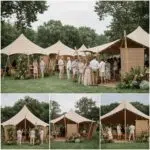The process of planning a wedding on a budget is a multifaceted task that requires careful consideration of every detail. One of the most critical aspects is selecting affordable wedding rental packages that do not compromise quality, style, or comfort. Couples must balance expenses such as tableware, linen, photography backdrops, and decorative elements like napkins, drapery, or even lighting—all while ensuring efficient customer service and logistical support from reliable rental companies. With rising wedding costs and economic fluctuations, budgeting wisely has become essential. This article is designed to guide event planners and couples in making informed decisions about wedding rentals by exploring the essential features of affordable packages, cost-saving opportunities, quality assessments, logistical organization, testimonials, and expert insights.
As a result, readers will gain valuable information to optimize their rental costs using smart strategies such as comparing bundle offers with individual rentals, finding seasonal deals, and working with vendors who provide exceptional support. With detailed analyses on topics ranging from package inclusions and vendor policies to maintenance procedures and insurance coverage, this guide serves as an all-encompassing resource. It also illustrates real-world examples where clients successfully maintained elegance within a confined budget, allowing them to plan a memorable wedding without undue financial strain.
By reading further, event planners and couples alike can learn how to effectively tailor rental packages to meet specific wedding needs while avoiding hidden fees related to shipping, payment processing, or damage deposits. Transitioning now to the main sections, the following guidelines will help you identify the best practices in affordable wedding rentals.
Identify Essential Features of Affordable Wedding Rental Packages

Affordable wedding rental packages should be evaluated on several fundamental criteria. First, it is important to assess the inclusions and exclusions of each package. A detailed review reveals which items are provided—such as table chairs, chiavari chairs, or white padded chairs—and which items may incur additional fees, like decor accents including garlands or floral designs. Evaluate the quality of linens and furniture, as well as associated digital services like online wedding portfolio support for photography set-up and other visual elements. Inclusions might also cover invitations for VIP services, additional lighting, and even pipe and drape installations. By knowing the exact contents of each rental, planners can better gauge the overall wedding reception ambience without overshooting the budget.
Evaluate Package Inclusions and Exclusions
Each wedding rental package varies in its inventory. A comprehensive package typically includes essential items such as chairs, tables, and decor items needed at the altar or dance floor. However, check whether additional items like photo booths, unique champagne glassware, or specific accented tableware are included or available at extra cost. Detailed inquiries should target what is provided in the initial fee versus what requires an add-on, such as extra drapery or decor elements. This approach ensures planners have visibility over their required investments and prevents unexpected expenses that might later impact the overall budget.
Analyze Pricing Structures and Added Value
Understanding pricing structures is crucial when comparing packages. Wedding rental companies may price their services based on per-item fees, flat rates, or bundle offers that incorporate aspects such as delivery logistics and setup schedules. Analyze if the added value aligns with the base price; certain vendors may charge a premium for enhanced customer service, superior inventory, or maintenance protocols, like insurance coverage for damaged equipment. For instance, some companies might offer a discount when booking multiple items together, which can reduce the overall price—ensuring that couples have more money available for items like wedding dresses or photography services. Examine each component of the cost, ensuring transparency in the fee structure and a clear indication of what the payment covers.
Review Vendor Policies and Logistical Support
Before finalizing a rental contract, it is essential to review the vendor policies and logistical support details. Consider policies regarding last-minute cancellations, damage waivers, and the process for addressing emergencies during the event. Some vendors provide robust logistical support, including precise instructions on the timing for delivery and evidence of an efficient warehouse inventory management system. Additionally, check if there is support for coordinating the logistics, such as setup and takedown schedules. High-quality vendors will offer clear communication lines—often via email addresses, phone lines, or personal account managers—ensuring a seamless experience on the big day. It’s also beneficial to inquire if they accept payment via credit card to ease transactions and provide added security against fraudulent charges.
Assess Cost-Saving Opportunities in Wedding Rentals
Budget-friendly weddings often hinge on smart cost-saving strategies in rentals. Cost-saving isn’t just about lowering the price but also about ensuring that the overall package meets quality standards while providing a stylish look. Assessing opportunities to cut costs means evaluating whether individual rental items might be less expensive when purchased separately instead of bundled—depending on the vendor’s pricing strategy. For many events, tailoring packages to suit specific needs, such as focusing on essential furniture for a wedding reception and avoiding extras like elaborate floral installations, helps maintain a comfortable budget without compromising aesthetic quality. Rental companies often provide seasonal deals and special promotions during off-peak periods, meaning that timing could lead to both quality and cost improvements.
Compare Bundle Offers Versus Individual Rentals
When considering rental options, it is crucial to compare bundle offers against individual rental purchases. Bundles might include several components such as chair sets, tables, and basic decor items at a discount. However, sometimes booking individual items separately gives refined control over quality—especially for key pieces like chiavari chairs or specialized tableware required for an upscale wedding reception. For example, while bundle offers might lower costs on a macro scale, individual rentals allow planners to invest the saved money in higher quality linens or a designer wedding visual arrangement. To make an informed decision, list up at least five key items typically needed, such as chairs, tables, lighting, linens, and decorative fixtures, and then compare the bundled price against the sum of individual rentals. This detailed examination not only aids in reducing expenditure but ensures that the emphasis is on quality without overspending.
Identify Seasonal Deals and Special Promotions
Seasonal deals and promotions provide another pathway to cost savings. Many rental companies offer discounted rates during off-peak wedding seasons or for early bookings. By planning ahead, couples can secure an optimal price that includes additional value-added services such as setup assistance or extended rental periods. Seasonal promotions might also align with flash sales or special package deals released during major events in wedding planning industries. It is advantageous to research and subscribe to these newsletters or check vendor websites frequently to leverage timely deals, which can significantly alter the final rental expenses in a positive way.
Tailor Packages to Fit Specific Wedding Needs
Budget-conscious planners should consider tailoring rental packages to the specific needs of the wedding. Not every event requires an extensive decorative backdrop or the entire gamut of luxury equipment. Customization allows planners to select only the necessary items for their reception—such as a simple yet elegant selection of tableware, minimalistic napkin designs, and basic floral decor—leaving room in the budget for promotional areas like a photo booth or a cocktail setup. For example, a ceremony held outdoors might emphasize natural elements, reducing the need for elaborate indoor decor. When vendors allow customization, the wedding planner can achieve a coherent theme while keeping costs predictable and transparent. Additionally, by matching the rental package to the event’s size and style, clients save money and benefit from a more streamlined logistical process where every rented item contributes to the overall design narrative without redundancy.
Examine Quality and Condition of Rental Items

Inspecting the quality and condition of rental items is a key factor that can affect both the look and longevity of a wedding setup. Quality assessment is not just about visual appeal; it involves understanding the durability and condition of items such as furniture, glassware, and decorative pieces like arches or drapery. High-quality rentals enhance a wedding’s overall appearance and, importantly, maintain the reputation of a rental company on long-term careers. Ensuring that items are well-maintained can also prevent last-minute issues such as breakdowns or unsightly wear and tear during the event. Furthermore, quality assessments help in identifying potential risks of damage, thereby reducing hidden costs that might arise from unplanned repairs or replacements.
Inspect Items for Durability and Appearance
A thorough physical inspection of rental items should be conducted prior to booking. For instance, check the condition of linens to ensure that their colors remain vibrant and that they are free from stains or damage. Chairs, especially chiavari chairs, should be checked for stability and overall finish. Furniture such as tables must be free from scratches and able to withstand weight without bending. It is recommended to obtain photos or videos that showcase these items in real-life settings, giving a closer depiction of how they will appear on the wedding day. Details such as the brightness of napkin colors and the texture of drapery fabric should also be evaluated. High standards in these areas ensure that when the equipment is delivered, it not only fulfills the functional need but also contributes to an aesthetically pleasing and photogenic event.
Confirm Maintenance Procedures and Insurance Coverage
Confirming the rental company’s maintenance procedures and insurance coverage is crucial. Reliable vendors will have a strict schedule for cleaning and maintaining their equipment, ensuring that items are in pristine condition before delivery. A well-documented maintenance log can serve as proof of the company’s commitment to quality. In addition, insurance coverage for rental items protects both the service provider and the client in case of accidents during the event. For example, if a piece of furniture is damaged during transit or setup, proper insurance ensures that replacement or compensation is promptly provided. It is advisable for planners to ask vendors about their protocols, including frequency of item inspections, replacement cycles, and methods of addressing any issues that arise during the event. Transparent maintenance standards and solid insurance policies significantly reduce financial risks and provide peace of mind for both wedding planners and couples.
Organize Rental Logistics Effectively
Effective organization of rental logistics is fundamental in ensuring that a wedding day runs smoothly. Scheduling the delivery and collection of rental items is an intricate process that requires detailed planning. It often involves coordinating various vendors and staff, specifying the exact times when items should be delivered, set up, or taken down, and ensuring clear communications throughout. The logistics of rental management also involve verifying that items such as tents, furniture, and decor are aligned with the scheduled timeline of the event. By having a well-organized plan, wedding planners can mitigate the risk of delays, damaged items, or scenarios where items might not arrive on time—all of which can negatively affect the wedding atmosphere and cause undue stress.
Plan the Timing for Delivery and Collection
The first step in effective logistics is planning the timing for delivery and collection. Most rental companies provide specific windows during which items will be delivered. It is important to choose time slots that allow sufficient time for setup before guests arrive. Equally, the pickup should be scheduled at a time when distractions are minimized, ideally after the event is completely over. Detailed timelines help coordinate with other services, such as photography and catering, ensuring that each vendor’s work does not overlap or interfere with another’s responsibilities. It can be advantageous to prepare a master schedule that includes key time markers, like start and end times of the reception, which allows all team members to work in unison and maintain the event flow.
Coordinate Setup and Takedown Schedules
Coordination between the setup and takedown schedules is essential to ensure that the rental items are displayed optimally and are removed promptly after the event concludes. The wedding planner should work with the rental company to assign dedicated time slots for both the arrangement of items such as chairs, tables, and decorative pieces, and their subsequent collection. This step involves synchronizing with the venue’s policies, such as permitted time slots for load-in and load-out, to avoid any potential penalties or delays. Detailed checklists compiled by the vendor can aid in confirming that no rental item is overlooked during setup, and that all items are efficiently organized for takedown. Establishing communication channels, such as direct phone lines or messaging groups among vendors, can further streamline the process. This ensures that any unexpected delays are quickly addressed, and the wedding schedule is adhered to without disruption.
Allocate Responsibilities Among Vendors and Staff
Assigning clear roles and responsibilities is crucial in the realm of rental logistics. The wedding planner should designate specific tasks for each member of the team; for example, one individual may be tasked with supervising the setup of furniture, while another manages the coordination of decor placements. This allocation extends to ensuring ticketed access for delivery personnel and addressing any last-minute modifications. Vendors might also assign a staff member to oversee item inspections upon arrival, thereby immediately identifying and reporting any discrepancies in quality or quantity. By having a well-structured plan that outlines responsibilities, both the wedding planners and vendors can achieve efficient teamwork and reduce the chances of critical delays or errors. Additionally, this strategic allocation supports a smoother breakdown of the event, where every item is accounted for and promptly collected, thus safeguarding the rental company’s inventory and ensuring future service quality.
Frequently Asked Questions
Q: What should couples look for in affordable wedding rental packages? A: Couples should focus on the contents of the package, ensuring that essentials like linens, furniture, tableware, and decor are included. Also, review pricing structures, vendor policies, and logistical support to avoid hidden costs while maintaining high quality.
Q: How can bundle offers help in saving costs? A: Bundle offers typically provide a discount when renting multiple items together, which can result in significant savings compared to renting items individually. Evaluating bundle packages and comparing them with separate rentals can maximize budget savings while ensuring quality.
Q: Why is logistical planning important for wedding rentals? A: Careful logistical planning ensures that rental items are delivered, set up, and collected on time. This coordination minimizes delays, prevents damage, and guarantees a seamless experience on the wedding day, which is essential for maintaining the event’s flow and style.
Q: How do maintenance procedures and insurance coverage affect rental quality? A: Maintenance procedures ensure that items such as furniture, linens, and decor are in top condition for the event. Additionally, insurance coverage protects both the client and the vendor from unexpected damages, reducing potential financial risks.
Q: What are some expert tips for getting the best deals on wedding rentals? A: Experts suggest early planning, comparing bundle versus individual rental prices, and capitalizing on seasonal promotions. They also recommend negotiating vendor terms and integrating feedback from past clients to ensure that quality and affordability go hand in hand.
Q: Can vendor recommendations really help in choosing the right rental items? A: Yes, vendors have extensive experience from handling numerous weddings. Their recommendations, combined with client testimonials, provide insights into which rental items deliver both quality and value, making it easier to tailor packages for specific wedding needs.
Q: Is it necessary to tailor rental packages for different wedding styles? A: Absolutely. Tailoring rental packages allows you to pick only the items necessary for your wedding theme, avoiding extra costs for items that do not contribute to the desired aesthetic. This customization helps maintain budget control while ensuring a cohesive wedding design.
Final Thoughts
Selecting the right wedding rental package on a budget is a critical step in planning a memorable and stylish wedding event. By carefully assessing package inclusions, comparing pricing models, and ensuring rigorous quality and logistical standards, couples can achieve elegance without excessive expenditure. Wariness about hidden fees and the importance of vendor transparency play an essential role in making informed rental decisions. Ultimately, by leveraging expert insights and real-life testimonials, wedding planners can confidently navigate the rental market to secure offerings that fulfill both quality and budget requirements.






